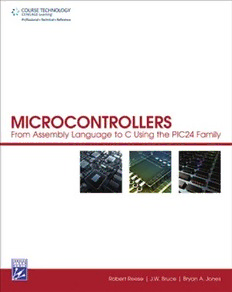Table Of Content.
Microcontrollers: From
Assembly Language to C
Using the PIC24 Family
Robert Reese
.
J.W. Bruce
Bryan A. Jones
Australia • Brazil • Japan • Korea • Mexico • Singapore • Spain • United Kingdom • United States
Microcontrollers: From Assembly Language © 2009, Course Technology, a part of Cengage Learning
to C Using the PIC24 Family
ALL RIGHTS RESERVED. No part of this work covered by the copyright herein
Robert Reese may be reproduced, transmitted, stored, or used in any form or by any means
J. W. Bruce graphic, electronic, or mechanical, including but not limited to photocopy-
ing, recording, scanning, digitizing, taping, Web distribution, information
Bryan A. Jones
networks, or information storage and retrieval systems, except as permitted
Publisher and General Manager, under Section 107 or 108 of the 1976 United States Copyright Act, without
Course Technology PTR: the prior written permission of the publisher.
Stacy L. Hiquet
Associate Director of Marketing: For product information and technology assistance, contact us at
Sarah Panella Cengage Learning Customer & Sales Support, 1-800-354-9706
Content Project Manager: Jessica McNavich For permission to use material from this text or product, submit all
requests online at cengage.com/permissions.
Marketing Manager: Mark Hughes
Further permissions questions can be e-mailed to
Acquisitions Editor: Mitzi Koontz [email protected]
Copy Editor:
Library of Congress Control Number: 2008938144
Technical Reviewer: Dr. Sam Russ
ISBN-13: 978-1-5845-0583-9
CRM Editorial Services Coordinator: ISBN-10: 1-5845-0583-4
Jennifer Blaney
eISBN-10: 1-5845-0633-4
Cover Designer: Mike Tanamachi
Course Technology
CD-Rom Producer: Brandon Penticuff
25 Thomson P.lace
Indexer: Boston, MA 02210
Proofreader: USA
Compositor: S4Carlisle Publishing Services
Cengage Learning is a leading provider of customized learning solutions with
office locations around the globe, including Singapore, the United Kingdom,
Australia, Mexico, Brazil, and Japan. Locate your local office at: international.
cengage.com/region
Cengage Learning products are represented in Canada by Nelson Education,
Ltd.
For your lifelong learning solutions, visit courseptr.com
Visit our corporate website at cengage.com
Certain materials contained herein are reprinted with permission of M icrochip
Printed in Canada
TechnologyIncorporated. No further reprints or reproductions may be made
1 2 3 4 5 6 7 12 11 10 09 08 of said materials withoutMicrochip Technology Inc.’s prior written consent.
RBR: To my Dad, a quiet hero.
JWB: To my family, who make me whole.
BAJ: To my beloved wife and to my Lord; soli Deogloria.
.
This page intentionally left blank
.
Acknowledgments
The authors would like to thank the following individuals for their assistance in
preparing this book:
ECE3724 students for their patience during the development of this text and
the accompanying software libraries.
Lee Hathcock and the students in ECE4723 who provided so many construc-
tive comments on the organization of ESOS.
Samuel Russ for his many insights on code and text improvements in his role
as a technical reviewer for the manuscript.
David Weaver, previously of Bell .Laboratories, for serving as an ad-hoc techni-
cal reviewer and who provided many excellent suggestions for code and text
improvements.
Nathan Seidle of SparkFun Electronics for his collaboration and support on
the mini-Bully PIC24 μC platform.
Carol Popovich and the other members of the Microchip Academic Program
team at Microchip Technology Inc. for their support in using Microchip prod-
ucts in a higher education environment.
v
This page intentionally left blank
.
About the Authors
Robert B. Reese received the B.S. degree from Louisiana Tech University, Ruston, in
1979 and the M.S. and Ph.D. degrees from Texas A&M University, College Station, in
1982 and 1985, respectively, all in electrical engineering. He served as a member of
the technical staff of the Microelectronics and Computer Technology Corporation
(MCC), Austin, TX, from 1985 to 1988. Since 1988, he has been with the Depart-
ment of Electrical and Computer Engineering at Mississippi State University, where
he is an Associate Professor. Courses that he teaches include Microprocessors, VLSI
systems, Digital System design, and senior design. His research interests include
self-timed digital systems and computer architecture.
J.W. Bruce received the B.S.E. fr.om the University of Alabama in Huntsville
in 1991, the M.S.E.E. from the Georgia Institute of Technology in 1993, and the
Ph.D. from the University of Nevada Las Vegas in 2000, all in electrical engineering.
Dr. Bruce has served as a member of the technical staff at the Mevatec Corporation
providing engineering support to the Marshall Space Flight Center Microgravity
Research Program. He also worked in the 3D Workstation Graphics Group at the
Integraph Corporation designing the world’s first OpenGL graphics accelerator for
the Windows operating system. Since 2000, Dr. Bruce has served in the Department
of Electrical and Computer Engineering at Mississippi State University. Dr. Bruce
has contributed to the research areas of data converter architecture design and
embedded systems design. His research has resulted in more than 30 technical pub-
lications and one book chapter.
Bryan A. Jones received the B.S.E.E. and M.S. degrees in electrical engineering
from Rice University, Houston, TX, in 1995 and 2002, respectively, and the Ph.D.
degree in electrical engineering from Clemson University, Clemson, SC, in 2005.
From 1996 to 2000, he was a Hardware Design Engineer for Compaq, specializing
in board layout for high-availability RAID controllers. He is currently an Assistant
Professor at Mississippi State University. His research interests include robotics,
real-time control-system implementation, rapid prototyping for real-time systems,
and modeling and analysis of mechatronic systems.
vii
This page intentionally left blank
.
Contents
Acknowledgments v
About the Authors vii
Introduction xxi
Part I Digital Logic Review and Computer Architecture Fundamentals 1
1 Number System and Digital Logic Review 3
Binary Data 4
Unsigned Number Conversion 6
Hex to Binary, Binary to Hex 7
Binary and Hex Arithmetic 8
Binary and Hex Addition 8
.
Binary and Hex Subtraction 9
Shift Operations 11
Combinational Logic Functions 12
Logic Gate CMOS Implementations 15
Combinational Building Blocks 18
The Multiplexer 18
The Adder 19
The Incrementer 20
The Shifter 21
Memory 21
Sequential Logic 22
The Clock Signal 23
The D Flip-Flop 24
ix

